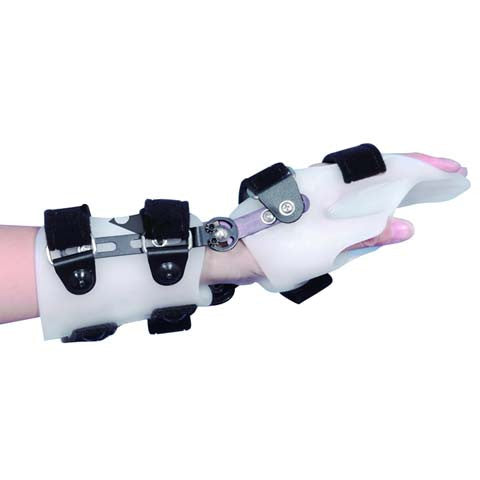HINGED WRIST HAND ORTHOSIS
A hinged wrist hand orthosis is a medical brace designed to support, stabilize, and immobilize the wrist and hand. This type of orthosis is often used in the treatment and rehabilitation of various conditions affecting the wrist and hand, such as carpal tunnel syndrome, fractures, post-operative recovery, and chronic conditions like arthritis. The hinge feature allows for adjustable control over the wrist's range of motion, providing a balance between immobilization for healing and some movement to maintain flexibility and strength. When selecting or using a hinged wrist hand orthosis, it's important to have it properly fitted and to follow medical advice for the duration and manner of use.
Causes
Wrist hand orthosis may be prescribed for various conditions such as wrist sprains, fractures, carpal tunnel syndrome, arthritis, or tendonitis. Proper diagnosis is essential to determine the specific cause.
Treatment Plan
Immobilization: Wearing the orthosis to immobilize the wrist and hand to allow healing.
Physical Therapy: Engaging in specific exercises to restore strength and flexibility.
Medications: Nonsteroidal anti-inflammatory drugs (NSAIDs) may be prescribed for pain and inflammation.
Occupational Therapy: Learning techniques to perform daily activities with the orthosis on.

HINGED WRIST HAND ORTHOSIS
Indications:
- After surgical repair
- After cast management
- Soft tissue contracture management
Features:
- Alllow for range between 0˚-35˚ of flexion and extension
- Facilitate the healing of soft tissue injuries and fracture
- Made of 4.5mm PE
- Prefabricated supporting splint with anatomical shape
- With inner glove against friction
The HINGED WRIST HAND ORTHOSIS products are well-received for providing back support and pain relief. Users appreciate the braces for their ability to stabilize the lower back, with one customer on komzer specifically noting the significant support the brace offered, enabling her to walk comfortably. It's important for the brace to be properly fitted by a medical professional to avoid complications such as skin irritation or circulation issues. For detailed product reviews and experiences, it's recommended to visit websites like komzer, which offer customer feedback on various WRIST HAND ORTHOSIS products.
SOFT RESTING HAND SPLINT
• Provides injured or painful wrist the support it needs during day and overnight rest
• Reduces and prevents painful flexion contractions that can accompany the post-stroke recovery process
• Decreases pain and inflammation of painful wrist and thumb tendonitis
• Keeps fingers, wrist and thumb secured in a functional position
• Rigid molded plastic splint, comfortably padded, with removable and washable microbial fabric cover that eliminates odors, perspiration and other issues
INDICATIONS LISTED BELOW
• Post stroke rehabilitation
• Metacarpal breaks
• Sprained knuckle
• Tendonitis
• Post-operative care
• Carpal tunnel syndrome
MEDICAL APPLICATIONS SPRAIN AND STRAIN CONDITIONS
These affect the connective tissues around the joints. Sprains are injuries to ligaments.The injury can be considered mild (slight stretching), moderate (partial tear), or severe(complete tearing). One or more ligaments can be injured in a sprain. The severity of the strain will depend on the extent of injury to a single ligament (whether the tear is partial or complete) and the number of ligaments involved.
Wrist supports or braces are applied to support and compress the soft tissues, helping to reduce swelling and relieve pain. They also provide varying degrees of stability to help prevent re-injury. Wrist braces are also an excellent post-operative tool to speed recovery and help maintain necessary activities during recuperation.
The conditions shown below may not be treated by the product listed on this page. Please view the above Medical Applications Chart to determine what conditions this page's associated product treats.

MILD STRAINS
A mild strain can occur for a number of reasons, but is most often caused by a person’s weight being applied to a wrist that is at an unnatural angle - eversion or inversion - with the ligament or ligament group being stretched or even torn.

MODERATE & SEVERE SPRAINS
A moderate sprain is slight tearing of a ligament or ligament group, while a severe sprain will always be a complete, and usually among a ligament group. Sprains are deemed mild, moderate or severe based on the extent of injury and the number of ligaments.

CARPAL TUNNEL SYNDROME
Carpal tunnel syndrome – or CTS – is repetitive-motion trauma of the hand and wrist. Symptoms of this painful disorder include numbness, tingling, weakness and aching of the hand and arm. The pain of carpal tunnel syndrome arises when the median nerve that passes through the wrist bones – or carpal tunnel – becomes pinched by swollen tendons and membranes. Damage to the nerve is cumulative and, if gone untreated for too long, can result in permanent loss of sensory and motor abilities.

WRIST AND FOREARM ANATOMY
- A. Median Nerve
- B. Radial Bursa
- C. Ulnar Nerve
- D. Transverse Carpal Ligament
